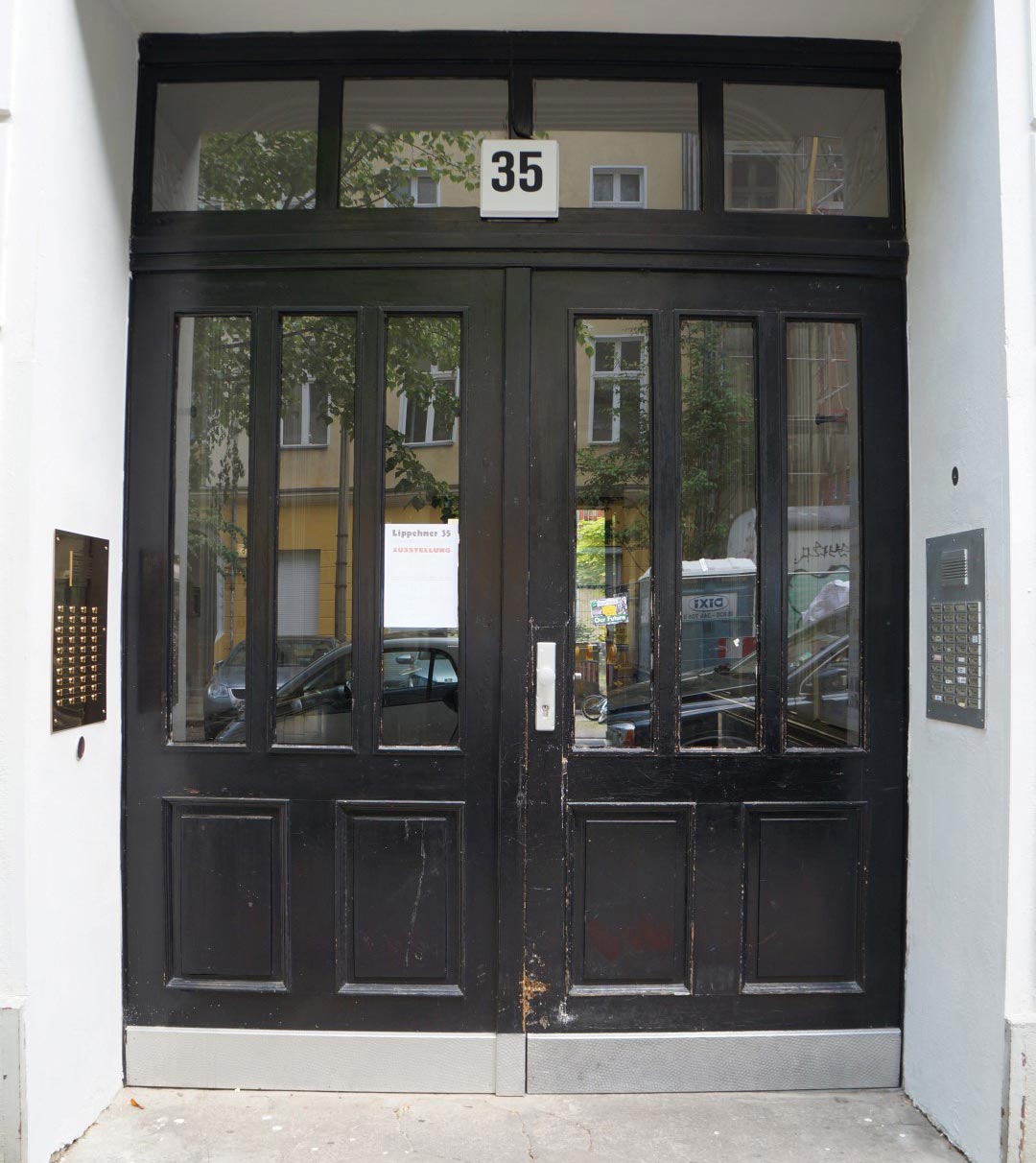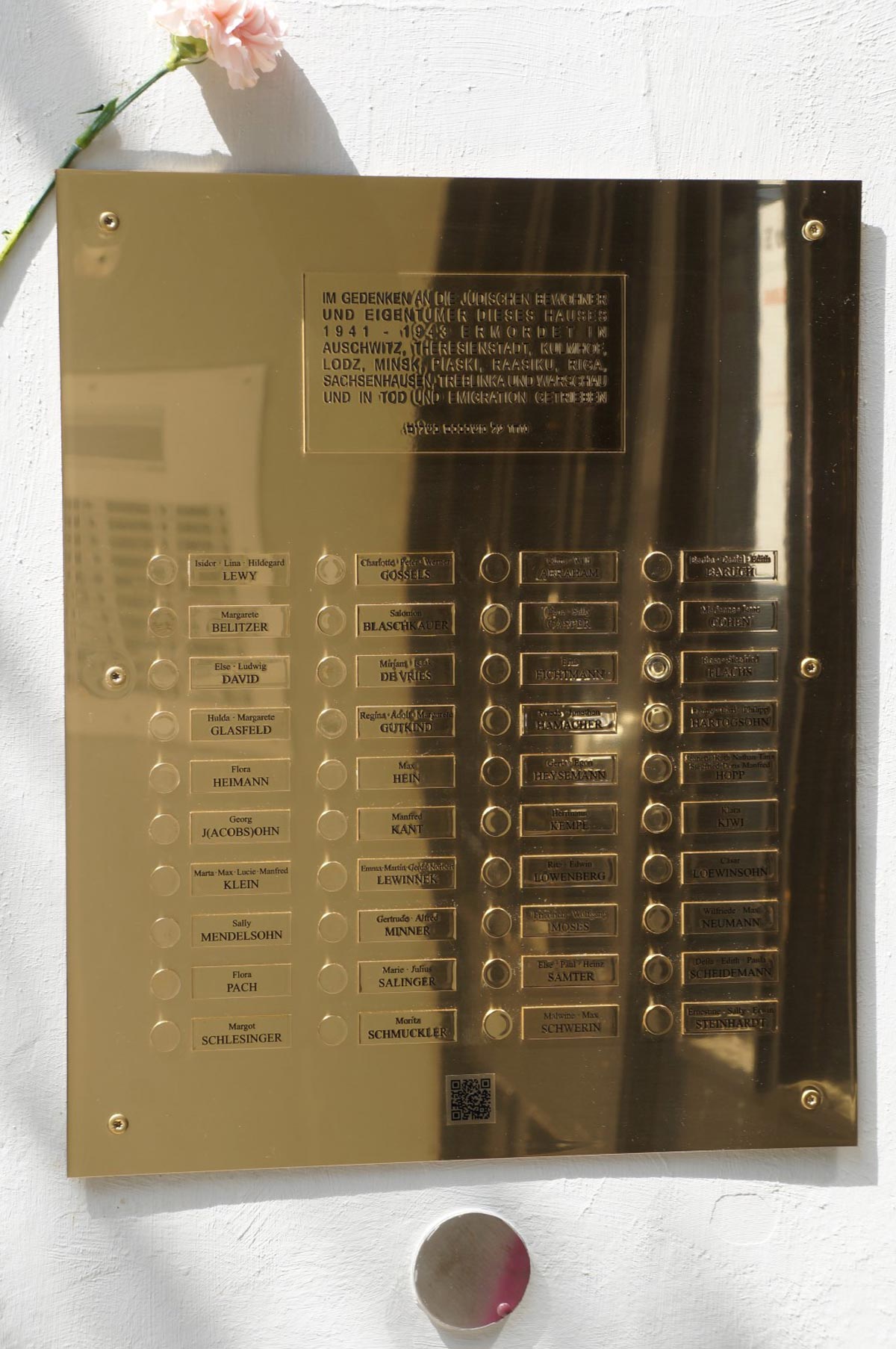Ringing in Your Ears
Silence and memory in Berlin
Lily Scherlis

The basic function of a doorbell is to facilitate a call and response through walls. Depressing the button, the visitor closes an electrical circuit, sending a signal through the infrastructure toward a piece of hardware that emits noise in the chosen room. In a multi-apartment building, the resident, now aware of the presence of an unseen visitor on the threshold, can press a button that sends a current back downstairs, releasing the door’s lock.
There is a building in the neighborhood of Bötzowviertel in northeast Berlin with a panel of doorbells that make no sound. This special bell board at 35 Käthe-Niederkirchner-Straße is a memorial: the names listed next to the bells belong to eighty-three Jews who occupied the building’s forty apartments prior to their deportation, escape, or death during the Nazi era.
The silent bell board was designed over the past year by Simon Lütgemeyer, an architect who has lived in the building since 1999. Beginning in March 2018, Lütgemeyer spent his evenings researching the building’s past. Working primarily from the German census of 1939 (which required residents to fill out cards reporting any Jewish heritage), as well as old address books and records of the expropriation of assets, Lütgemeyer produced extensive documentation of the lives and fates of the eighty-three residents.
Until 1974, the building’s address was 35 Lippehner Straße, the street taking its name from the German town of Lippehne. Under GDR administration in divided Berlin, the street was renamed after German communist hero Käthe Niederkirchner, who fought alongside the Soviets during World War II, and the building was reborn as 35 Käthe-Niederkirchner-Straße. The silent bell board at 35 Lippehner Straße has a not-so-silent twin in 35 Käthe-Niederkirchner-Straße’s working intercom system, which bears the names of the forty families currently in residence. The two are mirror images: they have precisely the same design and dimensions, though Lippehner’s is made of high-gloss polished brass while Niederkirchner’s is dull metal and plastic. Niederkirchner’s bell board has a voice box; in its place on the memorial, engraved words in German and Hebrew speak on behalf of the former residents. Unlike its functional counterpart, Lippehner’s forty brass buttons, one “doorbell” for each family, cannot be depressed. If you could in fact press them, doorbells might ring in the void.

• • •
The silent bell board was unveiled on 12 May, and biographical information for each of the former residents was included in a temporary exhibition that took place in the building’s vestibule; their stories, as well as the history of the building, are more permanently available online.
The area that the building occupies was once farmland owned by the Bötzow family. In 1885, the family, rich from agriculture, started selling off parcels, and investors began to build housing. The plot that would become 35 Lippehner Straße was bought in 1903 by mason Herrmann Knoll, who designed and built an Art Nouveau apartment building that he sold to Isidor and Lina Lewy. For the next few decades, 35 Lippehner was home to residents from a variety of social classes, some Jewish. Isidor died in 1936, leaving the building to Lina.[1] In 1938, the Nazis issued a decree that prohibited Jews from owning real estate, and Lina was forced to sell the building for a pittance to Richard and Charlotte Klaus, a Nazi-aligned couple who signed all their letters “Heil Hitler!”
The same year that Lina Lewy lost the building, the Nazis passed a law accelerating ghettoization by enabling landlords to evict Jewish residents without reason, claiming that “German-blooded” people should no longer have to live with Jews. The building was designated housing for Jewish families; the law required that tenants accommodate uprooted Jews as lodgers in their own homes, and the house began to fill.[2] Lina Lewy was arrested and deported in 1942; her daughter Charlotte Gossels was forced to work as a slave laborer and later killed at Auschwitz, but not before she managed to put her young sons Peter and Werner on a train to France in 1939. Four residents, Edwin and Rita Löwenberg and the sisters Hulda and Margarete Glasfeld, committed suicide in the house; sixty-five were transported to camps. Lütgemeyer tracked many of the transports through accounts of residents’ assets, written upon their arrest. Dealers often removed their furniture from 35 Lippehner within a day.
• • •
The doorbells are the house’s chosen alternative to placing Stolpersteine, “stumbling stones,” in the sidewalk. A stumbling stone is a ten-by-ten-centimeter, brass-plated plaque that contains the name and basic biographical information of an individual persecuted by the Nazi regime; it is embedded into the ground outside of the last dwelling where the person voluntarily chose to live before being deported or escaping the country. The vast, decentralized memorial project is the work of German artist Gunter Demnig, who tries to install every stone himself, and has personally placed around seventy thousand over the past twenty-five years.[3]
Some do not like the stones. Munich has banned Stolpersteine entirely. It doesn’t dignify those persecuted, detractors argue, to walk all over their memory. Early in the process, Lütgemeyer got in touch with Peter Gossels, who was nine when placed on the train to France and is now a lawyer living in Wayland, Massachusetts. (He and his younger brother Werner had in fact recovered ownership of the building from GDR state administration after the wall fell, and soon thereafter sold it to the present owner, donating all of the proceeds, mostly to public schools and libraries in and around Wayland.)
When Lütgemeyer discussed a possible memorial at 35 Niederkirchner with Gossels, shortly after neighbors down the street had Stolpersteine installed, Gossels said he would prefer something else. Stolpersteine for eighty-three people would have taken up nearly a square meter, making it challenging for bicyclists and others to avoid running over them. Lütgemeyer, for example, recently watched sanitation workers drag trash bins over the neighbors’ Stolpersteine, wheels bouncing loudly. Nonetheless, the stones exert quiet power over the sidewalk: they don’t demand attention, but simply mark the silent embeddedness of violent histories in physical space. The silent bell board picks up this symbolic strategy and runs with it. The doorbells map memory onto the space at hand: visitors envision Lippehner’s residents going about their days in imagined rooms, projecting into the unseen space behind 35 Niederkirchner’s façade.
Because it imitates a useful tool in the urban ecosystem, the silent bell board has an odd way of participating in the street’s economy of attention. Those who deal with doorbells more often are more inclined to notice it than others. The memorial’s de facto audience is delivery people and first-time guests of current residents. Employees of some mail services, such as Deutsche Post and Pin, have keys to 35 Niederkirchner. But other mail services like DHL, as well as food delivery apps, do not and have to ring the bell to get access. Lütgemeyer’s neighbor found one befuddled mailman staring blankly at the memorial, hoping to use it to access the building but unable to find the name on his package. “We guess this will continue to happen,” Lütgemeyer told me.4
In its unexpected silence, the memorial becomes an object that draws attention to itself by refusing to fulfill its purported function. By convincingly impersonating a working bell board, it does its work of reminding by producing a double-take. Visitors stumble unawares from Käthe-Niederkirchner-Straße onto the threshold of 35 Lippehner Straße. Though it could perhaps be sardonically accused of selectively inconveniencing delivery service employees with the memory of the Holocaust, it raises the question of how a memorial ought to behave, whether it should be polite, or intrude boldly into daily life.[5]
• • •
The silent bell board is actually an anachronism. Doorbells were still uncommon in Germany in the 1940s. The vestibules of multi-family buildings were equipped with stille Portiers, “silent porters,” wooden signs that diagrammed who lived in which apartment, enabling a visitor to find their way to the correct door and knock. The first electric bell board wasn’t installed at 35 Niederkirchner until just after the wall fell, when a private company placed doorbells in East Berlin and billed individual residents for their monthly use.
A real bell board, such as Niederkirchner’s, is an organic thing, a gauge of the constant flux of renters. In Germany, only mail with a matching name will be delivered, so the labels change as people move in and out: names scrawled on scrap paper replace the house manager’s neatly typed cards behind the plastic casing. Lazy newcomers put stickers on the plastic, which later get written over. The silent bell board, by contrast, is engraved metal: those whose names it lists will be in residence here forever. If a doorbell is a means of placing a request for entry, of reaching out through space to someone with the ability to unlock the door, then the memorial symbolically grants long-departed residents continued dominion over the building. The silent bell board implies that they are still reachable, but then, confronting visitors with buttons they cannot actually press, it reminds us why they are not.
- Lewy seems to have died from natural causes rather than as a direct result of Nazi persecution. Lütgemeyer felt it was nonetheless important to include Lewy’s name, as he is a central figure in 35 Lippehner’s history and the grandfather of two surviving residents.
- Lütgemeyer estimates that despite the law, at least half of the forty-two apartments in the building at the time were occupied by non-Jewish families for the duration of the war. Jewish families shared the remaining twenty or so apartments, often each occupying only a single room.
- Demnig holds a trademark for Stolpersteine.
- When Lütgemeyer sent sketches to the sign manufacturer for an estimate, the confused company thought he wanted to know what it would cost to make a functioning electrical bell board from the design.
- The position that the silent bell board occupies to the side of the door has unintentionally and loosely alludes to the Jewish tradition of affixing a small, encased parchment scroll, called a mezuzah, to the doorway of one’s home (though they are generally attached to the right side, while the silent bell board is on the left). The name of God is written on the parchment, as well as a short text from the Old Testament. It is meant to serve as a daily reminder of the unity of God as one passes in and out of the home, and an invitation to contemplate him.
Lily Scherlis is a writer and artist interested in the devices (like doorbells) that let people feel in touch with one another. She has contributed to Harvard Magazine and the Harvard Advocate, and is about to start a PhD program in English at the University of Chicago. She lives in Berlin.
Spotted an error? Email us at corrections at cabinetmagazine dot org.
If you’ve enjoyed the free articles that we offer on our site, please consider subscribing to our nonprofit magazine. You get twelve online issues and unlimited access to all our archives.